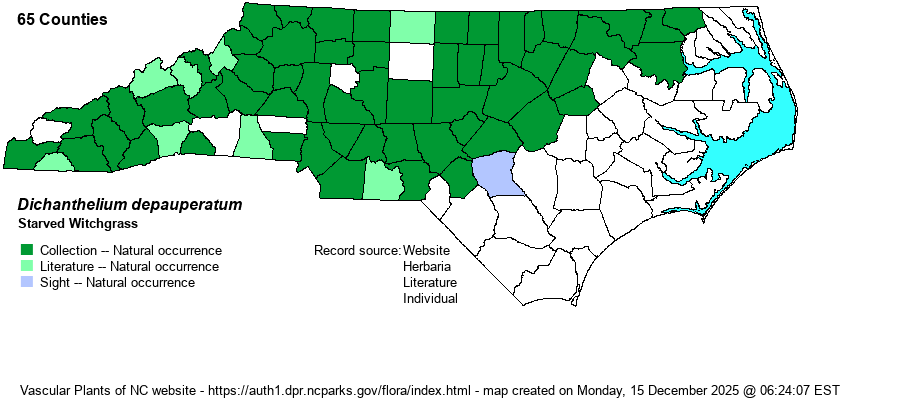| Author | (Muhlenberg) Gould | |
| Distribution | Mountains, Piedmont, and northwestern Coastal Plain; scarce in the Sandhills proper.
Newf. to MN south to GA and TX. | |
| Abundance | Frequent to common, except absent from most of the Coastal Plain; infrequent in the northwestern Coastal Plain. This is clearly an S5 species. | |
| Habitat | Dry soils of woodland and forest openings, rock outcrops, fields, trails, roadsides, powerlines, railroad margins. | |
| Phenology | Flowering and fruiting May-September. | |
| Identification | This is one of the few witchgrasses that does not produce an obvious rosette of leaves at ground level. Rather, all leaves are alike and in this case erect to strongly ascending, long, and linear. The lower leaves are much more numerous than upper ones. From D. linearifolium, it is best told by the longer spikelets (3.2-4.3 mm long vs. 2.0-3.2 mm long in that species). | |
| Taxonomic Comments | None, other than being named as Panicum depauperatum in older references.
A note about Dichanthelium: This genus is not impossible to identify to species! But it takes applied effort over a period of time in order to learn the various species and what their morphological limits are. We strongly recommend that you read the introduction to the treatment in Weakley et al. (2023), written by Richard LeBlond. LeBlond has made order out of near chaos, and his keys work very well for our plants. Most Dichanthelium taxa ("Dichs") do not grow everywhere indiscrimminately, but prefer certain well-defined habitats. Note that most species produce flowers/fruits twice a year -- a vernal period and an autumnal period -- and that measurements of spikelets and achenes are taken from vernal plants. Some species also have a third, or summer, period. In the vernal period there is a single inflorescence at the tip of the stem. In the autumnal period, plants produce elongate branches with bunched (congested) leaves and so look quite different from vernal plants. Inflorescences are produced in leaf axils as well as at the tips of branches. NOTE: Older texts had these species essentially all within the very large genus Panicum. "Dich" species are typically named as "Witchgrass" and Panicum species named as "Panicgrass". | |
| Other Common Name(s) | Starved Panicgrass, Starved Rosette-panicgrass | |
| State Rank | S4 [S5] | |
| Global Rank | G5 | |
| State Status | | |
| US Status | | |
| USACE-agcp | | |
| USACE-emp | | |

